tow AUDI S6 2012 User Guide
[x] Cancel search | Manufacturer: AUDI, Model Year: 2012, Model line: S6, Model: AUDI S6 2012Pages: 298, PDF Size: 74.43 MB
Page 73 of 298
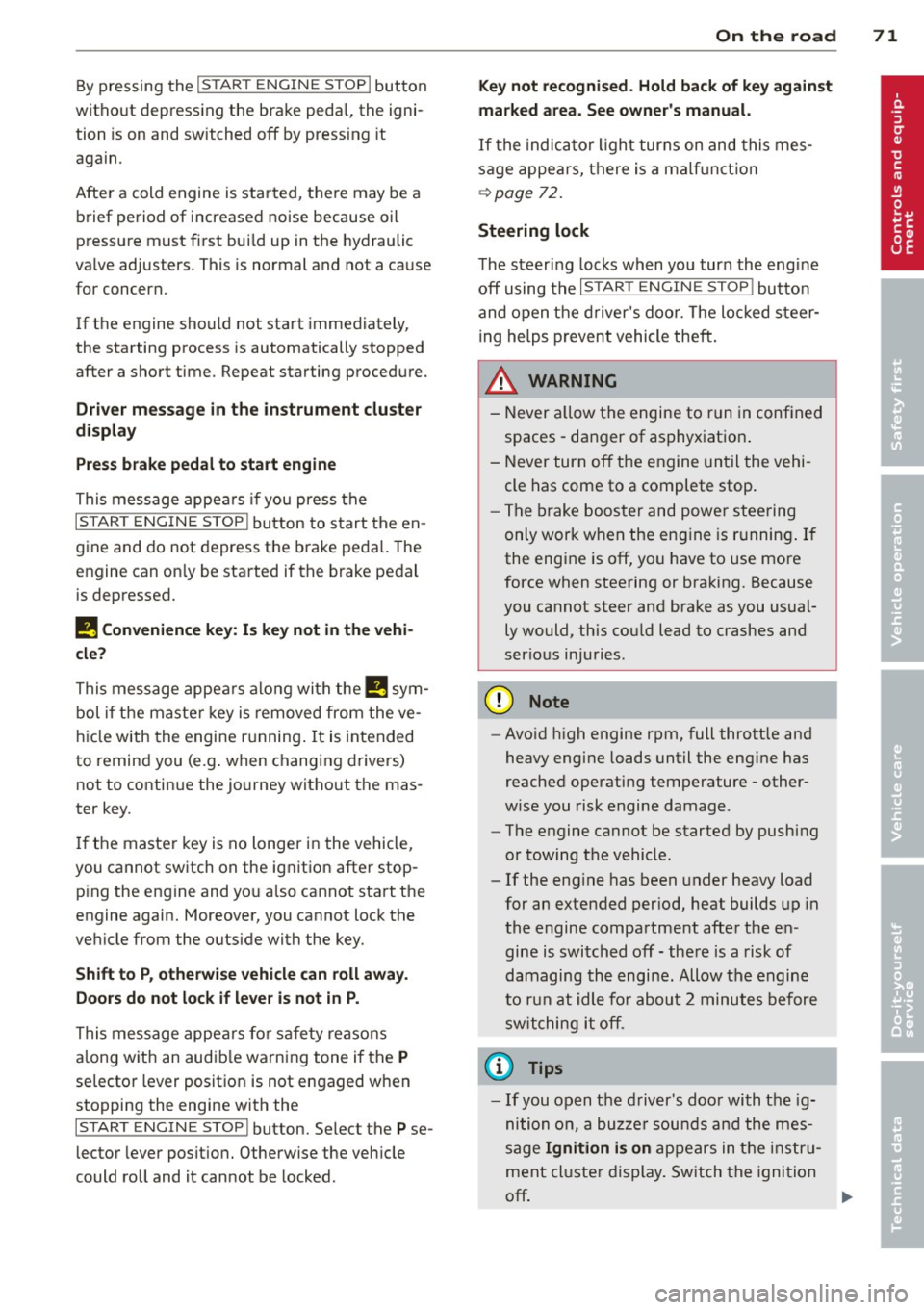
By pressing the I START ENGINE STOPI button
without depressing the brake peda l, the igni
tion is on and switched
off by pressing it
again.
After a cold engine is started, the re may be a
brief period of increased noise because oil
pressure must first bui ld up in the hydraulic
va lve adjusters. This is normal and not a cause
for concern.
If the engine should not start immediately,
the starting process is automatically stopped
after a short time. Repeat starting procedure.
Driv er m essag e in th e in strument clu ste r
disp lay
Pr ess br ak e p ed al to start engin e
This message appears if you press the
I START ENGINE STOP ! button to start the en
g ine and do not depress the brake peda l. The
engine can on ly be started if the brake pedal
is depressed.
!!I C o nv enience ke y: I s ke y not in th e vehi
cle ?
This message appea rs a long with the !!I sym
bol if the maste r key is removed from the ve
hicle with the engine r unning . It is intended
to remind you (e .g . when changing drivers)
not to continue the journey witho ut the mas
ter key.
I f the master key is no longer in the vehicle,
you cannot sw itch on the ignition after stop
ping the engine and yo u also cannot start the
engine again. Moreover, you cannot lock the
veh icle from the outside with the key.
Shift to P , other wis e vehicle c an roll away.
Doo rs do not lock if le ver i s not in P.
This message appears for sa fety reasons
a long with an audib le warning tone if the
P
selector lever position is not engaged when
stopping the eng ine with the
I STAR T ENGINE STOP ! button. Select the P se
lector lever posit ion. Otherwise the veh icle
could roll and it can not be locked .
On th e ro ad 71
Ke y not r ecogni sed . Hold bac k of ke y again st
ma rked area. See owne r's manual.
If the indica tor l ight turns on and this mes
sage appears, there is a malf unct ion
¢ page 72.
Steering lock
The steering locks when you turn the engine
off using the I START ENGINE STOP ! button
and open the d river's doo r. T he locked steer
i ng helps p revent vehicle theft.
& WARNING ~
- Never allow the engine to run in confined
spaces -danger of asphyxiation .
- Never turn
off the engine un til the vehi
cle has come to a complete stop .
- The brake booster and power steering
only work when the eng ine is r unning . If
the engine is
off, you have to use more
force when steering or braking. Because
you cannot steer and brake as you usual ly would, this cou ld lead to crashes and
serious injuries.
(CT) Note
- Avo id h igh engine rpm, full thrott le and
heavy engine loads until the engine has
reached operating temperature -other
w ise you risk engine damage .
- The engine cannot be started by pushing
or towing the vehicle.
- If the engine has been under heavy load
for an extended per iod, heat builds up in
the engine compa rtment afte r the e n
gine is switched
off -there is a risk of
damaging the engine. Allow the engine
to run at idle fo r about 2 minutes before
switching it
off.
(D Tips
- If you open the d river 's doo r with the ig
nition on, a buz ze r sounds and the mes
sage
Ignition i s on appears in the instr u
ment cl uste r display . Sw itch the ignition
off . Ill-
Page 79 of 298

pass someone. The speed you saved ea rlier
will resume as soon as you release the acceler
ator peda l.
I f, however, yo u exceed your saved speed by
6 mph (10 km/h) for longer than 5 min utes,
the cruise contro l will turn off temporarily.
The green symbol
iB;O)~i~ (US mode ls) ;l'I
(Canad ian models) in the display will go out
but the saved speed remains the same.
Presetting your speed
App lies to vehicles: with cr uise contro l
You con preset your desired speed while the
vehicle is not moving.
~ Switch on the ignition.
~ Pu ll lever into position CD ¢ page 76,
fig. 75.
~ Press the lever in the 0 or 0 direction to
i ncrease or decrease your speed.
~ Release the lever to save that speed.
This funct ion makes it possible, for example,
to save the speed you want before driving on
the highway . Once on the highway, activate
the c ruise control by pull ing t he lever towa rd
(D .
Switching the system off
App lies to vehicles: with c ruise con tro l
Temporary deactivation
~ Press the brake peda l, or
~ Press the lever i nto pos ition @ (not clicked
in to p lace)
¢ page 76, fig. 75, or
~ Drive for longer than 5 minutes at more
than 5 mph (10 km/h) above the stored
speed.
Sw itching off completely
~ Press leve r into position @(clic ked into
pla ce), o r
~ Switch the ignition off.
The system reta ins the saved speed if you de
activa te the cru ise con tro l temporarily. To re
sume the saved speed, release the brake ped
a l and pull the lever to position
(D .
On th e ro ad 77
Switching the ignition off e rases the saved
speed.
A WARNING
You shou ld only ret urn to the saved speed
if it is not too fast for the c urrent traffic
conditions -risk of an accident!
Page 80 of 298
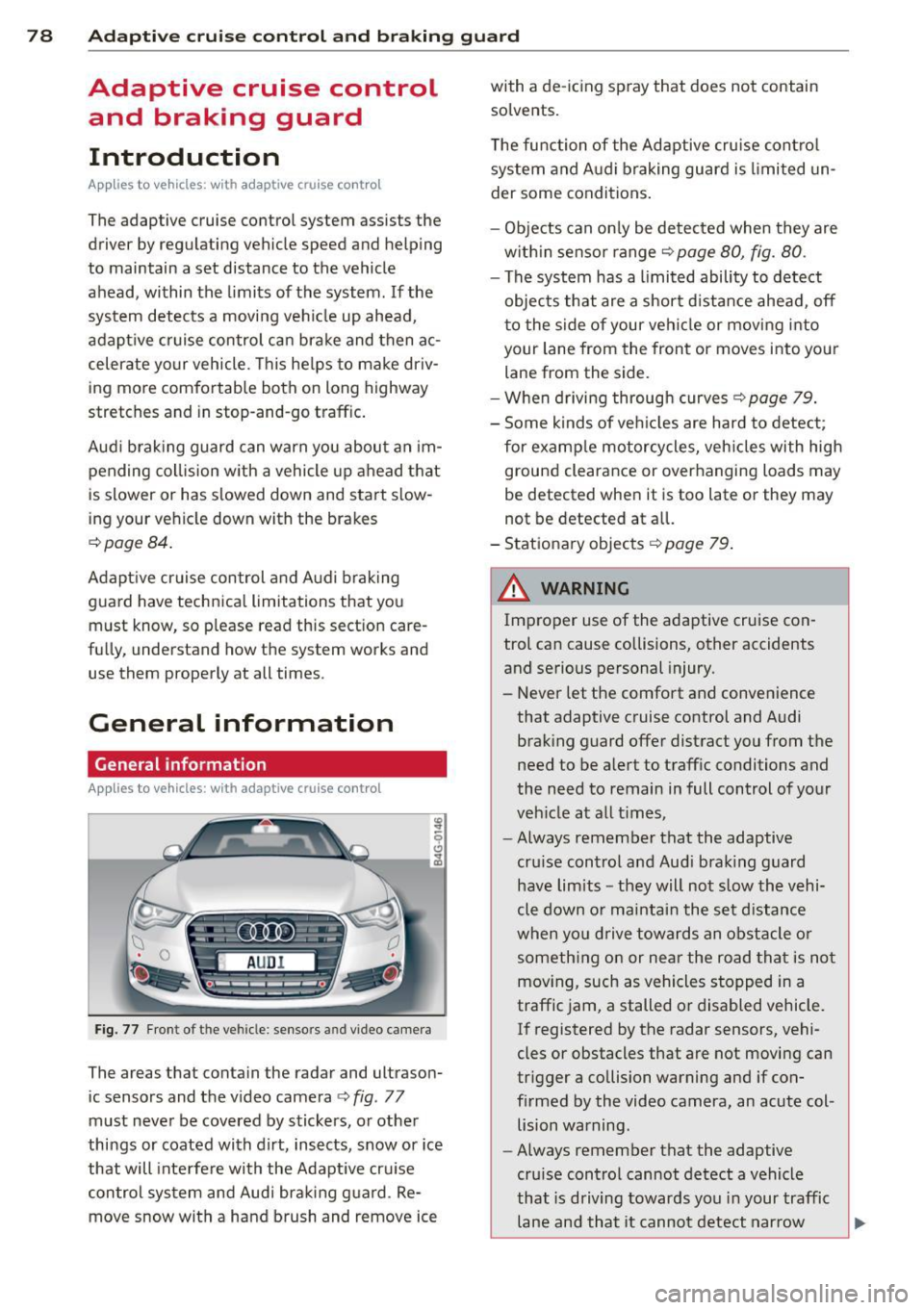
78 Adaptive cruise control and braking guard
Adaptive cruise control
and braking guard
Introduction
Applies to vehicles: with adaptive cruise co ntrol
The adaptive cruise control system assists the
driver by regulating vehicle speed and helping
to maintain a set distance to the vehicle
ahead, within the limits of the system . If the
system detects a moving vehicle up ahead,
adaptive cruise control can brake and then ac
celerate your vehicle . This helps to make driv
ing more comfortable both on long highway
stretches and in stop -and-go traffic.
Aud i braking guard can warn you about an im
pending collision with a vehicle up ahead that
is slower or has slowed down and start slow
ing your vehicle down with the brakes
<::> page 84.
Adaptive cruise control and Audi braking
guard have technical limitations that you
must know, so please read this section care
fully, understand how the system works and
use them properly at all times.
General information
General information
Applies to vehicles: with adaptive cruise control
Fig. 77 Front of th e ve hicle : senso rs a nd vi deo camera
The areas that contain the radar and ultrason
ic sensors and the video camera
c::> fig . 77
must never be covered by stickers, or other
things or coated with dirt, insects, snow or ice
that will interfere with the Adaptive cruise
control system and Audi braking guard . Re
move snow with a hand brush and remove ice with a de-icing spray that does not contain
solvents.
The function of the Adaptive cruise control
system and Audi braking guard is limited un
der some conditions.
- Objects can only be detected when they are
within sensor range
c::> page 80, fig. 80.
- The system has a limited ability to detect
objects that are a short d istance ahead, off
to the side of your vehicle or moving into
your lane from the front or moves into your
lane from the side.
-When driving through curves
r=;>page 79.
- Some kinds of vehicles are hard to detect;
for examp le motorcycles, vehicles with high
ground clearance or overhanging loads may
be detected when it is too late or they may
not be detected at all.
- Stationary objects
c::> page 79 .
A WARNING
Improper use of the adaptive cruise con
trol can cause collisions, other accidents
and serious personal injury. -
-Never let the comfort and convenience
that adaptive cruise control and Audi
braking guard offer distract you from the
need to be alert to traffic conditions and
the need to remain in full control of your
vehicle at all times,
- Always remember that the adaptive
cru ise control and Audi braking guard
have lim its -they will not slow the vehi
cle down or maintain the set distance
when you drive towards an obstacle or
something on or near the road that is not
moving, such as vehicles stopped in a
traffic jam, a stalled or disabled vehicle.
If registered by the radar sensors, vehi
cles or obstacles that are not moving can
trigger a collision warning and if con
firmed by the video camera, an acute col lision warning.
- Always remember that the adaptive
cruise control cannot detect a vehicle
that is driving towards you in your traffic
lane and that it cannot detect narrow
~
Page 82 of 298
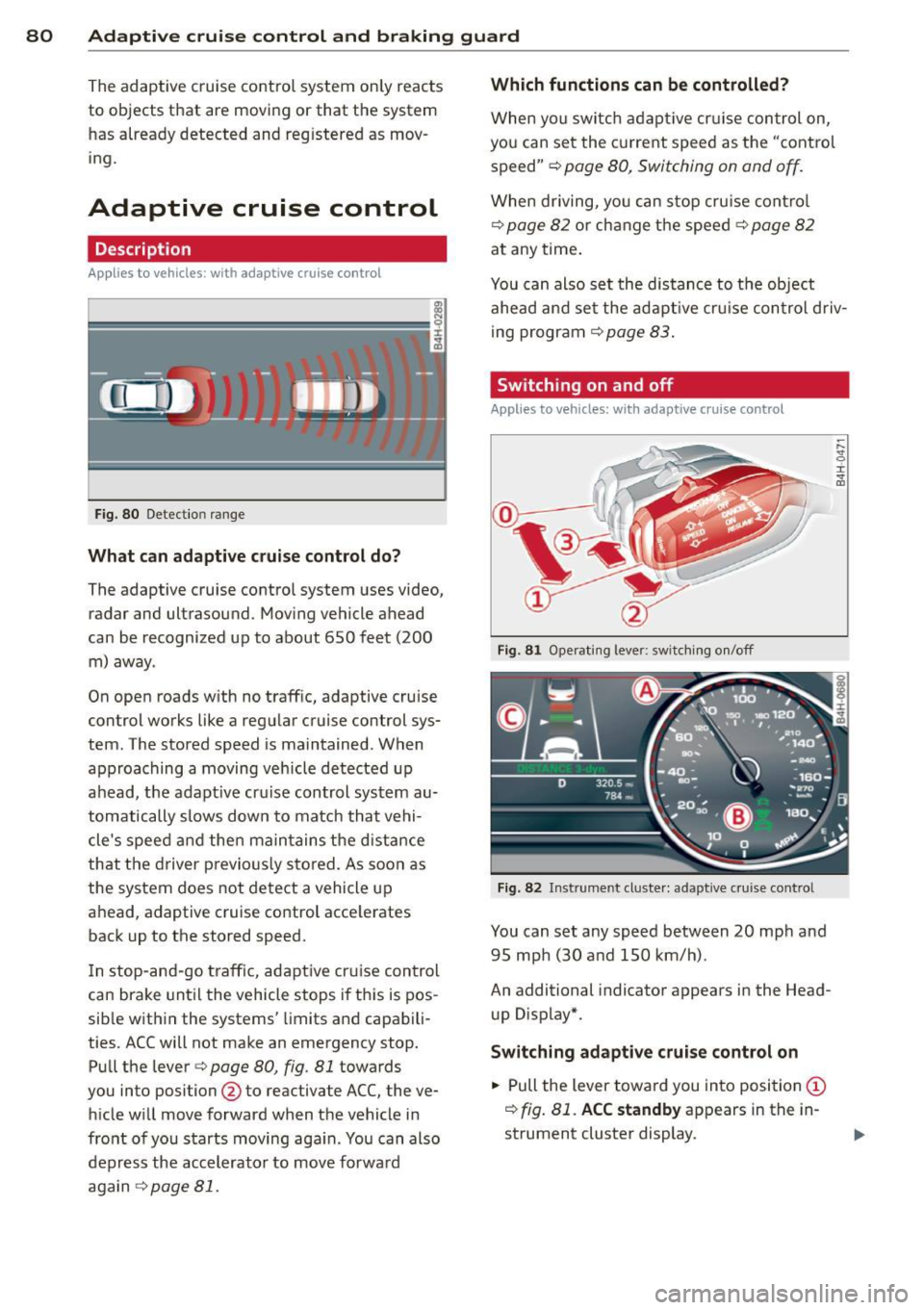
80 Adaptive cruise control and braking guard
The adaptive cruise control system on ly reacts
to objects that are moving or that the system has already detected and reg istered as mov
ing.
Adaptive cruise control
Description
Applies to vehicles: with adaptive cruise control
Fig . 80 Detection range
What can adaptive cruise control do?
The adaptive cruise control system uses video,
radar and ultrasound. Moving vehicle ahead
can be recognized up to about 650 feet (200 m) away.
On open roads with no traffic, adaptive cruise
control works like a regu lar cruise control sys
tem. The stored speed is maintained. When
approaching a moving vehicle detected up
ahead, the adapt ive cruise control system au
tomatically slows down to match that vehi
cle's speed and then ma intains the distance
that the driver previously stored. As soon as
the system does not detect a vehicle up
ahead, adaptive cruise control acce lerates
back up to the stored speed.
I n stop-and-go traffic, adaptive cruise control
can brake unt il the vehicle stops i f this is pos
sible with in the systems' limits and capabili
ties. ACC will not make an emergency stop.
Pull the lever<=>
page 80, fig. 81 towards
you into position @to reactivate ACC, the ve
hicle will move forward when the vehicle in
front of you starts moving aga in. You can also
depress the accelerator to move forwa rd
again <=>
page 81 .
Which functions can be controlled?
When you switc h adaptive cruis e control on,
you can set the current speed as the "control
speed" <=>
page 80, Switching on and off.
When driving, you can stop cruise contro l
<=>
page 82 or change the speed r::!> page 82
at any time.
You can also set the distance to the object
ahead and set the adaptive cruis e control driv
ing program
r::!> page 83.
Switching on and off
Applies to vehicles: with adaptive cruise control
Fig . 81 Operating lever: swit c hin g on/off
Fig . 82 Inst rument clus te r: adap tive cruise control
You can set any speed between 20 mph and
95 mph (30 and 150 km/h) .
An additional indicator appears in the Head
up Display*.
Switching adaptive cruise control on
.,. Pull the lever toward you into position (D
~ fig. 81. ACC standby appears in the in
strument cluster display.
Page 83 of 298
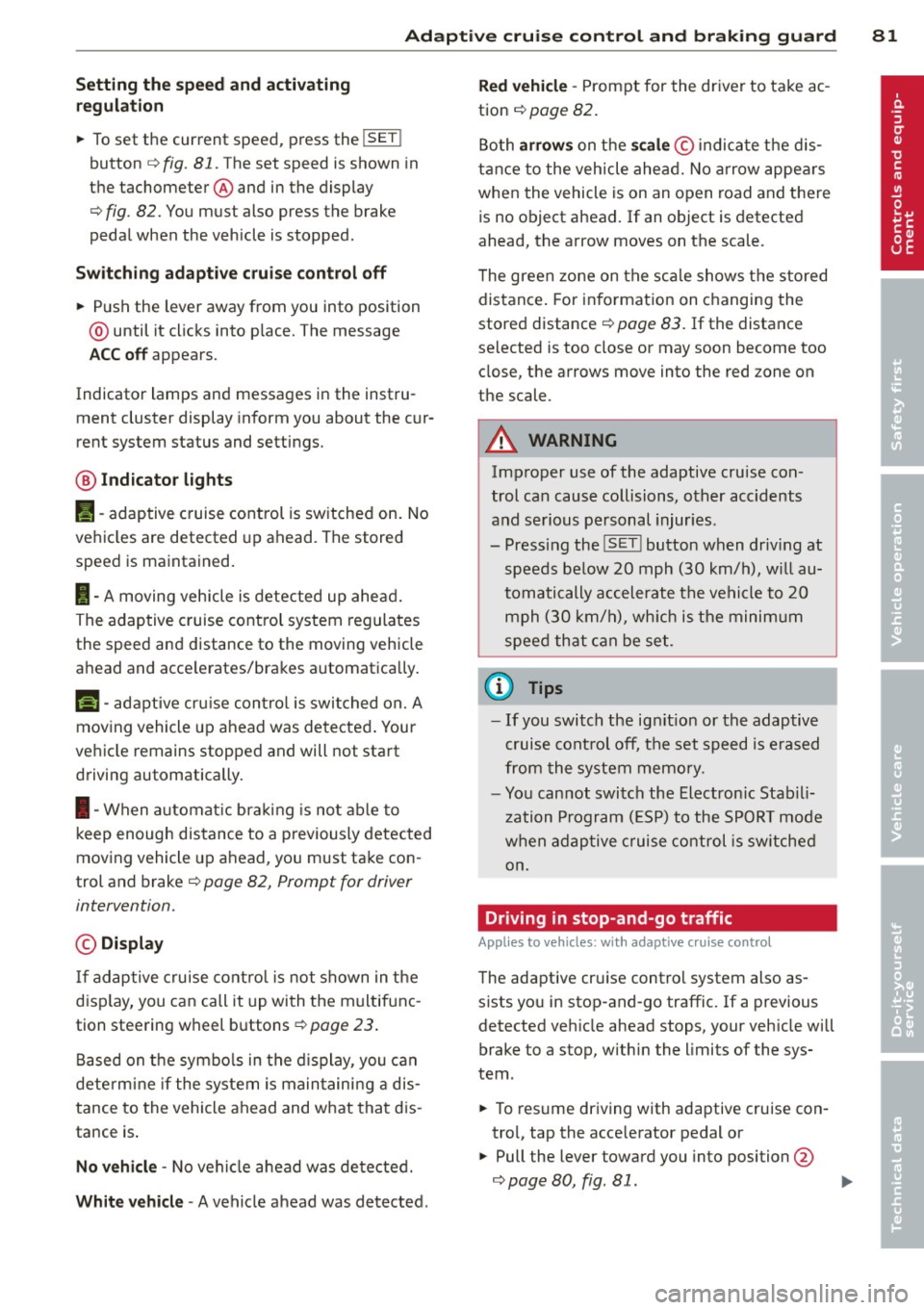
Adaptive cruise control and braking guard 81
Setting the speed and activating
regulation
~ To set the current speed, press the !SET !
button ¢ fig. 81. The set speed is shown in
the tachometer @and in the display
¢
fig . 82. You must also press the brake
pedal when the vehicle is stopped .
Switching adaptive cruise control off
~ Push the lever away from you into position
@ until it clicks into p lace. The message
ACC off appears.
Indicator lamps and messages in the instru
ment cluster display inform you about the cur
rent system status and settings.
@ Indicator lights
Pl -adaptive cruise control is switched on. No
vehicles are detected up ahead . The stored
speed is ma intained.
I -A moving vehicle is detected up ahead.
The adaptive cruise control system regulates
the speed and distance to the moving vehicle
ahead and acce lerates/brakes automatica lly.
Mi -adaptive cruise control is swit ched on. A
moving vehicle up ahead was detected . Your
vehicle remains stopped and will not start
driving automatically.
I -When automat ic brakin g is not able to
keep enough distance to a previously detected
moving vehicle up ahead, you must take con
trol and brake¢
page 82, Prompt for driver
intervention.
© Display
If adaptive cruise control is not shown in the
disp lay, you can call it up with the multifunc
tion steering wheel buttons
¢page 23.
Based on the symbo ls in the display, you can
determine if the system is maintaining a dis
tance to the vehicle ahead and what that dis
tance is .
No vehicle -No veh icle ahead was detected.
White vehicle -A vehicle ahead was detected .
Red vehicle -Prompt for the driver to take ac
tion ¢
page 82.
Both arrows on the scale© indicate the dis
tance to the vehicle ahead. No arrow appears
when the vehicle is on an open road and there
is no object ahead. If an object is detected
ahead, the arrow moves on the scale.
T he green zone on the scale shows the stored
distance . For information on changing the
stored distance ¢
page 83. If the distance
selected is too close or may soon become too
close, the arrows move into the red zone on
the scale .
A WARNING
Improper use of the adaptive cruise con
trol can cause collisions, other accidents
and serious personal injur ies.
- Pressing the
! SET ! button when driv ing at
speeds below
20 mph (30 km/h), will au
tomatically accelerate the vehicle to
20
mph (30 km/h), which is the minimum
speed that can be set.
(D Tips
-If you switch the ignit ion or the adaptive
cruise control off, the set speed is erased
from the system memory.
- You cannot switch the Electronic Stabili
zation Program (ESP) to the SPORT mode
w hen adaptive cruise control is switched
on.
Driving in stop-and-go traffic
Applies to veh icles: w ith adaptive c ruise control
The adaptive cruise contro l system also as
sists you in stop-and-go traffic. If a previous
detected vehicle ahead stops, your veh icle will
brake to a stop, within the limits of the sys
tem .
~ To resume driving with adaptive cruise con
trol, tap the acce lerator pedal or
~ Pull the lever toward you into position @
¢ page 80, fig. 81. ..,_
Page 84 of 298
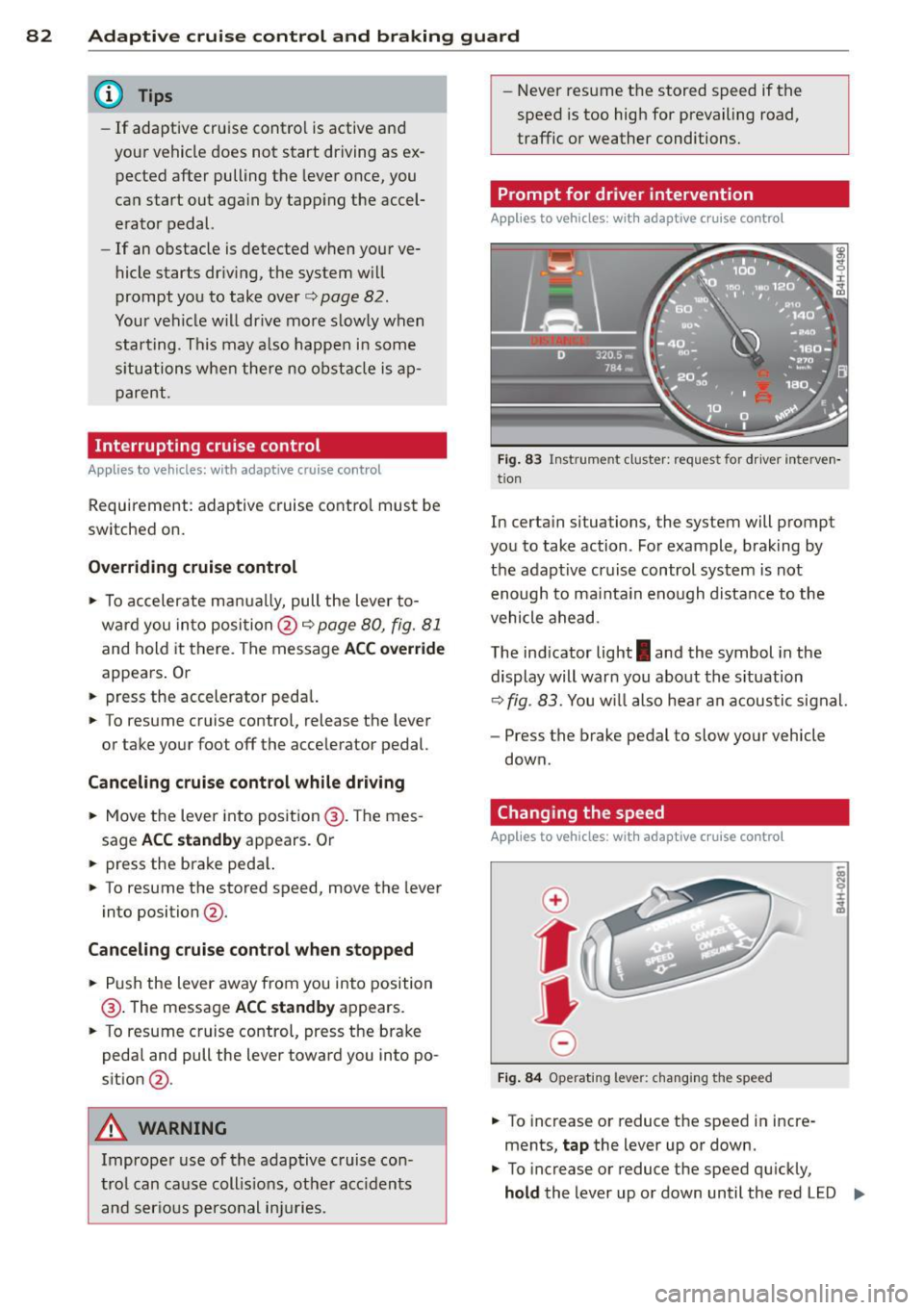
82 Adaptive cruise control and braking guard
@ Tips
-If adaptive cruise contro l is active and
your vehicle does not start dr iving as ex
pected after pulling the lever once, you
can start out aga in by tapp ing the accel
erator pedal.
- If an obstacle is detected when your ve
hicle starts dr iv ing, the system w ill
prompt you to take over
c> page 82.
Your vehicle w ill dr ive more slowly when
starting. This may a lso happen in some
situations when there no obstacle is ap
parent.
Interrupting cruise control
Applies to vehicles: with adaptive cruise control
Requirement: adaptive cruise control must be
switched on.
Overriding cruise control
., To accelerate manually, pull the lever to
ward you into position @~
page 80, fig. 81
and hold it there. The message ACC override
appears . Or
.. press the accelerator peda l.
.. To resume cruise control, release the lever
or take your foot off the accelerator pedal.
Canceling cruise control while driving
.. Move the lever into position @. The mes
sage
ACC standby appears. Or
.. press the brake peda l.
.. To resume the stored speed, move the lever
into position @.
Canceling cruise control when stopped
.. Push the lever away from you into position
· @ . The message
ACC standby appears .
.. To resume cruise control, press the brake
pedal and pull the lever toward you into po
sition @.
A WARNING
Improper use of the adaptive cruise con
trol can cause collisions, othe r acc idents
and serious personal injuries. -
Never resume t he stored speed if the
speed is too high for prevailing road,
traffic or weather conditions.
Prompt for driver intervention
Applies to vehicles: with adaptive cruise control
Fig. 83 Instrument cluster: requ est for driv er interve n·
tion
In certa in situations, the system will prompt
you to take action . For example, braking by
the adaptive cruise control system is not enough to mainta in enough distance to the
vehicle ahead.
The indicator light
I and the symbol in the
display will warn you about the situation
~ fig. 83. You wi ll also hear an acoustic signal.
- Press the brake pedal to slow your vehicle
down.
Changing the speed
Applies to vehicles: with adaptive cruise control
0
f
jJ
0
Fig. 84 Operating lever: changing the speed
.. To increase or reduce the speed in incre
ments,
tap the lever up or down.
.. To increase or reduce the speed qu ickly,
hold the lever up or down until the red LED ..,.
Page 95 of 298
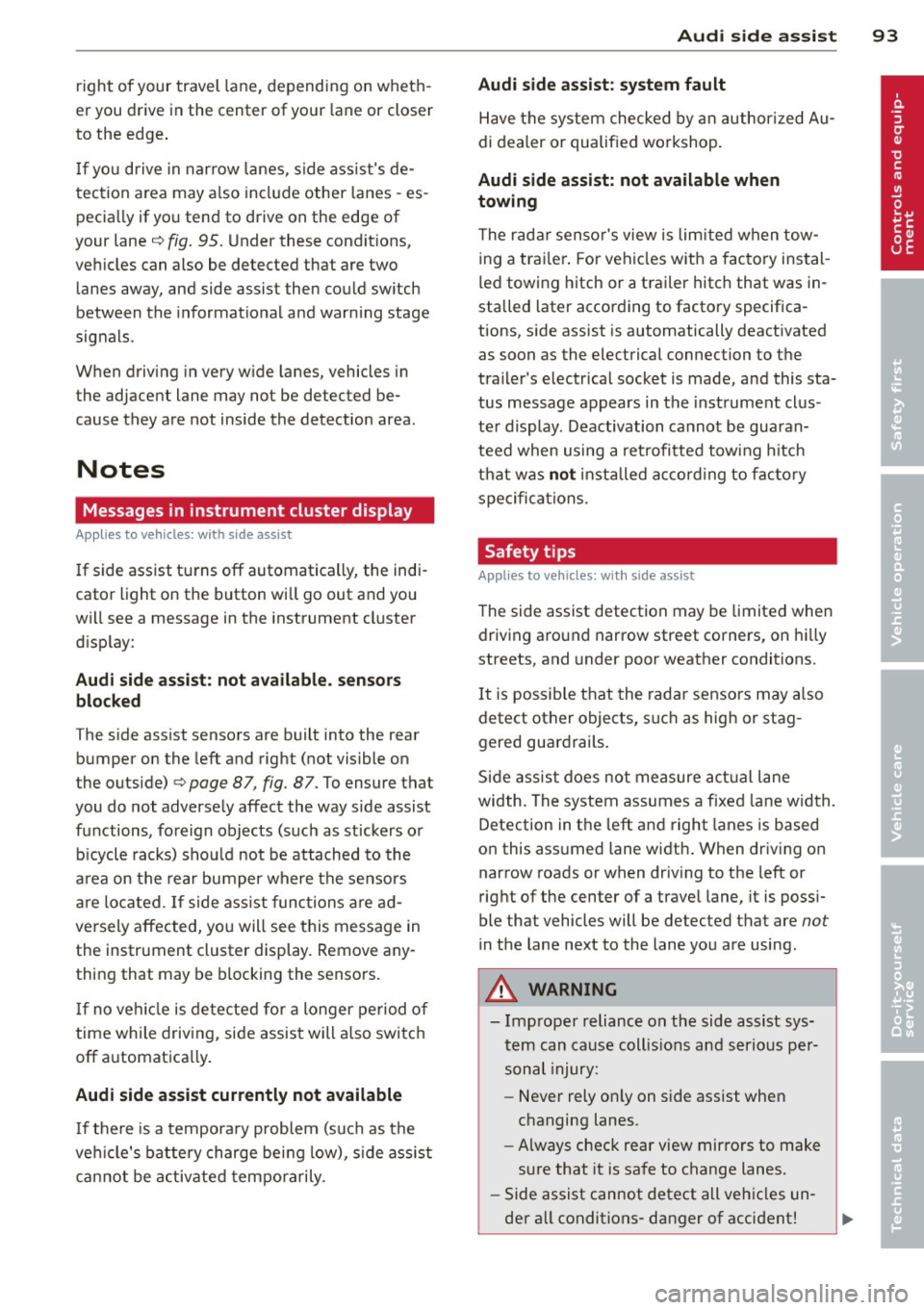
right of your travel lane, depending on wheth
er you driv e in the center of your lane or closer
to the edge .
I f yo u drive in narrow lanes, s ide ass ist's de
tection area may a lso include other lanes -es
pecia lly if you tend to drive on the edge of
your lane¢
fig. 95. Under these condit ions,
ve hicles can also be detected that are two
lanes away, and side assist then could sw itch
between the informat ional and warn ing stage
sig nals .
When driving in very w ide lanes, vehicles in
the adjacent lane may not be detected be
cause they are not inside the detection area .
Notes
Messages in instrument cluster display
Applies to vehicles: with side assist
If side assist turns off automatically, the indi
cator light on the button wi ll go out and you
will see a message in the instrument cl uster
d isplay:
Aud i side a ssist : not availab le. s en sors
blocked
T he side assist sensors are built into the rear
bumper on the left and right (not visible on
the outside) ¢
page 87, fig. 87. To ensure that
you do not adversely affect the way side assist functions, foreign objects (such as stickers o r
b icycle racks) shou ld not be attached to the
a rea on the rear bumper where the sensors
a re loca ted.
If side ass ist func tions a re ad
versely affected, yo u will see this message in
the instrument cluster display. Remove any
thing that may be blocking the sensors .
If no vehicle is detected for a longer period of
time while driving, side assis t will a lso switch
off a utomatica lly.
Audi side as sist currently not available
If there is a tempora ry problem (such as the
veh icle's battery charge being low), s ide ass ist
cannot be activated tempo rarily.
Audi side a ssis t 93
Audi side assist: system fault
Have the system checked by an author ized Au
di dealer or qualified workshop .
Audi side assist: not available when
to wing
T he radar sensor's view is limited when tow
ing a trai ler . F or vehicles with a facto ry instal
led towing hitch or a trailer hitch that was in
stalled later according to factory specifica
tions, side assist is automatically deactivated
a s soon as the electrical connection to the
trailer 's electrical socket is made, and this sta
tus message appears in the instrument clus
ter display . Deactivation cannot be guaran
teed when using a ret rofitted towing hitch
that was
not installed acco rd ing to facto ry
spe cifica tions.
Safety tips
Applies to vehicles: with side assist
T he side assist detection may be limited when
driving around narrow street corners, on hi lly
streets, and under poor weather conditions.
It is possible that the radar sensors may a lso
detect other objects, s uch as high or stag
gered guardrails .
S ide assist does not measure act ual lane
width. The system assumes a fixed lane width.
Detection in the left and right lanes is based
on this ass umed lane width . When driving on
narrow roads or when driving to the left or
right of the center of a travel lane, it is poss i
ble that vehicles will be detected that are
not
in the lane next to the lane you are using .
A WARNING
-Improper reliance on the side assist sys
tem can cause coll is ions and serio us pe r
sonal injury:
- Never rely on ly on side assist when
changing lanes .
- Always check rear view mirrors to make
sure that it is safe to change lanes.
- Side assist cannot detect all vehicles un-
der all conditions- danger of accident!
~
Page 104 of 298
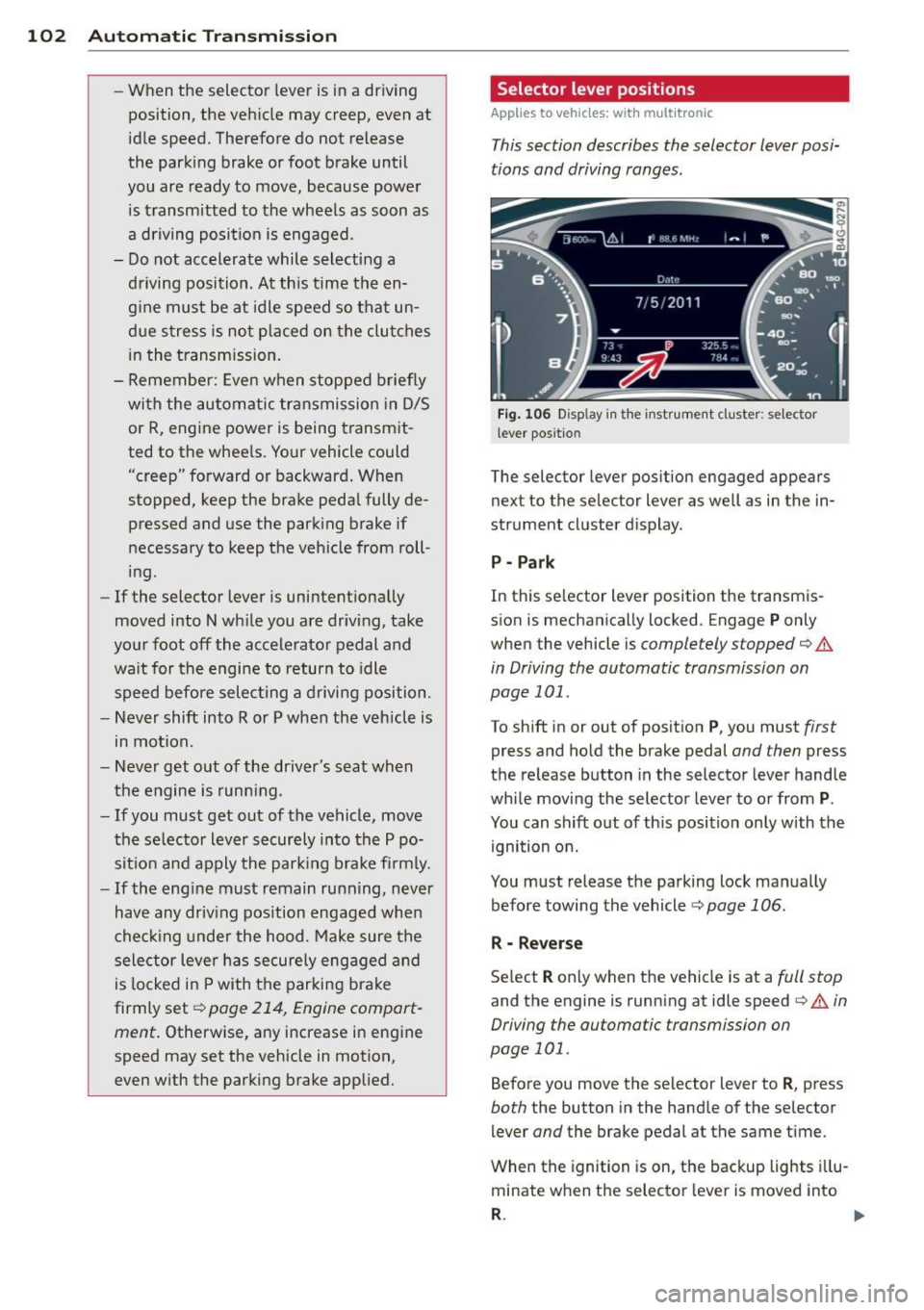
102 Autom atic Tran smi ssi on
-When the selector lever is in a driving
position, the veh icle may creep, even at
id le speed. Therefore do not release
the park ing brake or foot brake until
you are ready to move, because power
is transmitted to the wheels as soon as
a driving posit ion is engaged.
- Do not accelerate while selecting a
driving position. At this time the en
g ine must be at idle speed so that un
d ue stress is no t placed on the clutches
in the t ransmission.
- Remembe r: Even when stopped briefly
with the automatic transmission in D/S
or R, engine power is being transmit
ted to the whee ls. Yo ur vehicle could
"creep" forward or backward . When
stopped, keep the brake peda l fully de
pressed and use the parking brake if
necessary to keep the vehicle from roll
ing .
-If the selector lever is unintentionally
moved into N wh ile you are driving, take
yo ur foot off the accele rator pedal and
wa it for the engine to return to idle
speed befo re selec ting a drivi ng position.
- Never shift into R or P when the veh icle is
in mo tion.
- Never get out of the dr iver's seat when
the engine is runn ing.
- If you must get out of the vehicle, move
the se lector lever securely into the P po
si ti on a nd apply the park ing brake fi rm ly.
- If the eng ine must remain running, never
have any driv ing pos ition engaged when
chec king under the hood. Make sure the
selector lever has securely engaged and
is locked in P with the parking brake
firmly set¢
page 214, Engine comport
ment .
Otherwise, any increase in engine
speed may set the vehicle in mot ion,
even with the parking brake applied.
Selector lever positions
Applies to vehicles: wit h mult itronic
This section describes the selector lever posi
tions and driving ranges.
F ig . 106 Display in th e inst rument cluster: se lector
l ever positio n
The selector lever position engaged appears
next to the selector lever as well as in the in
strument cluster d isplay.
P - Par k
In this se lector lever position the transm is
sion is mechanically locked . Engage
P only
when the vehicle is
completely stopped¢.&
in Driving the automatic transmission on
page 101 .
To shift in or out of posit ion P , you must first
press and hold the brake pedal and then press
the re lease button in the selector lever handle
whi le moving the selector lever to o r from
P .
You can shift out of th is position only with the
ignition on.
You must release the parking lock manually before towing the vehicle ¢
page 106.
R - Reverse
Se lect R only when the vehicle is at a full stop
and the engine is running at idle speed¢.& in
Driving the automatic transmission on
page 101.
Before you move the selector lever to R , press
both the button in the hand le of the se lector
lever
and the brake pedal at the same t ime.
When the ignition is on, the backup lights i llu
minate when the selector lever is moved into
R . 1111-
Page 108 of 298

106 Automatic Transmission
Of course, you can continue to use the manual
shift program with the selector lever on the
center console.
Transmission malfunction
Applies to vehicles: with multitron ic
[O] Transmission: please press the brake ped·
al and select the position again
Press the brake pedal and se lect the desired
selector lever position again . You can then
continue dr iving .
[O] Transmission hot: please modify driving
style
The transmission temperature has increased
sig nifi cantly due to the sporty driving manner.
Drive in a less spo rty manner until the tem
perature returns to the normal range and the
indicator light switches of.
[O] Transmission malfunction: You can con
tinue driving
There is a sys tem ma lf unctio n in the transmis
sion . You may continue driving. Drive to your
authorized Audi dealer or qualified repair fa
cility soon to have the malfunction corrected .
[O] Transmission malfunction: Limited driv
ing functionality
There is a system malfunction in the transmis
sion . The transmission is switch ing to emer
gency mode. This mode only shifts into cer
tain gea rs or will no longer shift at all. The en
gine may stall. Drive to your authorized Audi
dealer or qualified repair facility immediately
to have the ma lfunction corrected.
[O] Transmission malfunction: Stop and shift
to P
Do not cont inue driving. Select the P se lector
l eve r position and see yo ur authorized Aud i
dealer or qualified repa ir facility for assis
tance.
(D Note
If the transmission switches to emergency
mode, you should take the vehicle to an a
uthor ized Audi dea le rs hip as soon as pos
sible to have the condition corrected .
Emergency release of the selector lever
Applies to vehicles: w ith multitronic
If the vehicle's power supply fails, the selec
tor lever con be released in on emergency .
Fig. 111 Emerge ncy release fo r selecto r lever
.,. To reach the emergency release mechanism,
remove the ashtray insert* .
.,. Loosen and remove the small cap in the
ashtray mount ¢
fig. 111 .
.,. You now have access to a bolt. Using a
screwdriver or similar, press the bolt down
and hold it down.
.,. Now press the interlock and move the se lec-
tor lever to the
N position.
T he selector lever can only be moved from the
P position if the ignition is turned on . If the
vehicle has to be pushed or towed if the power
supply fails (e .g. battery is discharged), the
se lector lever must first be moved to the
N
pos ition using the emergency locking device.
tiptronic ®
Introduction
Applies to veh icles : w ith tiptronic
Your vehicle is equipped with an electronically
controlled automatic transmission. Upshifting
and downsh ifting takes place
automatically .
The transmission is also equipped with t ip
tronic ®. It allows the driver to shift gears
manually if desired ~ page 110.
Page 110 of 298

108 Automatic Transmission
-If you must g et out of the vehicle, move
the selector lever securely into the P po
sition and apply the parking brake f irmly.
-If the engine must remain running, never
have any driving position engaged when
checking under the hood. Make sure the
selector lever has securely engaged and
is locked in P with the parking brake
firmly set
r:!;> page 214, Engine compart
ment.
Otherwise, any increase in engine
speed may set the vehicle in motion,
even with the parking brake applied.
Selector lever posit ions
Appl ies to vehicles: with tiptronic
This section describes the selector lever posi
tions and driving ranges.
Fig. 113 Display in the instrume nt cluster: se lector
lever pos itio n
The selector lever position engaged appears
next to the selector lever as well as in the in
strument cluster display.
P - Park
In this selecto r lever position the transmis
sion is mechanically locked . Engage
P only
when the vehicle is
completely stopped ¢ A
in Driving the automatic transmission on
page 107 .
To shift in or out of position P, you must first
press and hold the brake pedal and then press
the release button in the selector lever handle
while moving the selector lever to or from
P.
You can shift out of this position only with the
ignition on.
You must release the parking lock manually
before towing the vehicle
<:!;>page 112.
R -Reverse
Select R only when the vehicle is at a full stop
and the engine is running at idle speed r:!;> ,& in
Driving the automatic transmission on
page 107.
Before you move the selector lever to R, press
both the button in the handle of the selector
l ever
and the brake pedal at the same time.
When the ignition is on, the backup lights illu
minate when the selector lever is moved into
R.
N - Neutral
The transmission is in neutral in this position .
Shift to this position for standing with the
brakes applied
<:!;>page 109.
When the vehicle is stationary or at speeds
below 3 mph (5 km/h), you must always apply
the footbrake before and while moving the
lever out of
N.
D/S - Normal position for driving forward
In the D/S position, the transmission can be
operated either in the normal D mode or in
the S sport mode . To select the S sport mode,
pull the selector lever back briefly. Pulling the
lever back again will select the normal D
mode. The instrument cluster display shows
the selected driving mode.
In the
normal mode D , the transmission auto
matically selects the best gear ratio.
It de
p ends on engine load, vehicle speed and the
dynamic control program (DRP).
Select the
sport mode S for sporty driving.
The vehicle makes full use of the engine's
power. Shifting is more noticeable when accel
erating.
When the vehicle is stationary or at speeds
below 3 mph (5 km/h), you must always apply
the foot brake before and while moving the
lever to
D/S out of N .
In certain circumstances it may be advanta
geous to temporarily switch to the manual
shift program to manually select gear ratios .,..